
Francisco José de Goya y Lucientes was a Spanish romantic painter and printmaker. He is considered the most important Spanish artist of the late 18th and early 19th centuries. His paintings, drawings, and engravings reflected contemporary historical upheavals and influenced important 19th- and 20th-century painters. Goya is often referred to as the last of the Old Masters and the first of the moderns.

Charles IV was King of Spain and ruler of the Spanish Empire from 1788 to 1808.
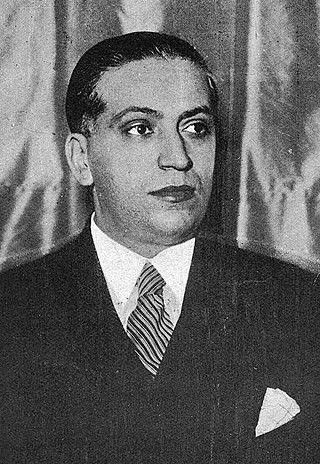
José Calvo Sotelo, 1st Duke of Calvo Sotelo, GE was a Spanish jurist and politician. He was the minister of finance during the dictatorship of Miguel Primo de Rivera and a leading figure during the Spanish Second Republic. During this period. he became an important part of Spanish Renovation, a monarchist movement. Calvo Sotelo's assassination in July 1936 by the bodyguard of PSOE party leader Indalecio Prieto was an immediate prelude to the triggering of the Spanish military coup of July 1936 that was plotted since February 1936, the partial failure of which marked the beginning of the Spanish Civil War.

Maria del Rosario Weiss Zorrilla was a Spanish painter and engraver best known for portraits. She was the goddaughter of Francisco de Goya and lived with him during his final years when her mother was his maid. Over seventy of her drawings, preserved at the Hispanic Society of America, were once attributed to Goya but, in 1956, the art historian José López-Rey demonstrated conclusively that they were hers.
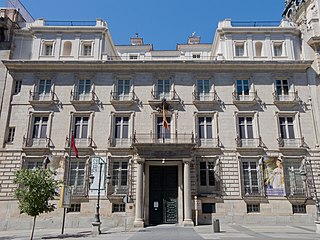
The Real Academia de Bellas Artes de San Fernando, located on the Calle de Alcalá in the centre of Madrid, currently functions as a museum and gallery. A public law corporation, it is integrated together with other Spanish royal academies in the Instituto de España.

Atropos, or The Fates is one of the 14 Black Paintings painted by Francisco de Goya between 1819–1823. Goya, then 75 and in mental and physical despair, created the series directly onto the interior walls of the house known as the Quinta del Sordo, purchased in 1819.

Judith and Holofernes is the name given to one of the 14 Black Paintings painted by Francisco de Goya between 1819 and 1823. By this time, Goya was in his mid 70s and deeply disillusioned. In mental and physical despair, he painted the private works on the interior walls of his home—applying oils directly on plaster—known as the Quinta del Sordo, which he had purchased in 1819. Judith and Holofernes was likely painted on the first floor, beside Saturn Devouring His Son. The picture is a personal reinterpretation of the narrative of the Book of Judith, in which the protagonist saves Israel from the assault of the general Holofernes by seducing and beheading him. Judith is the only historical figure who can be identified with certainty among the Black Paintings.

A Pilgrimage to San Isidro is one of the Black Paintings painted by Francisco de Goya between 1819–23 on the interior walls of the house known as Quinta del Sordo that he purchased in 1819. It probably occupied a wall on the first floor of the house, opposite The Great He-Goat.

The Inquisition Tribunal, also known as The Court of the Inquisition or The Inquisition Scene, is a 46-by-73-centimetre oil-on-panel painting produced by the Spanish artist Francisco Goya between 1812 and 1819. The painting belongs to a series which also includes Bullfight, The Madhouse and A Procession of Flagellants, all reflecting customs which liberals objected to and wished were abandoned, but their reform was opposed by the absolutist (autocratic) policy of Ferdinand VII of Spain.
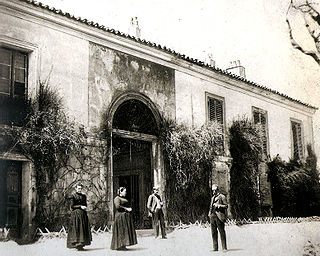
The Black Paintings is the name given to a group of 14 paintings by Francisco Goya from the later years of his life, likely between 1819 and 1823. They portray intense, haunting themes, reflective of both his fear of insanity and his bleak outlook on humanity. In 1819, at the age of 72, Goya moved into a two-story house outside Madrid that was called Quinta del Sordo. Although the house had been named after the previous owner, who was deaf, Goya too was nearly deaf at the time as a result of an unknown illness he had suffered when he was 46. The paintings originally were painted as murals on the walls of the house, later being "hacked off" the walls and attached to canvas by owner Baron Frédéric Émile d'Erlanger. They are now in the Museo del Prado in Madrid.

Jean Laurent or, in Spanish, Juan Laurent Minier; sometimes simply J. Laurent was a French photographer who mostly worked in Spain.

Youth Front was a Spanish political youth organization and far-right militant group, sometimes considered a terrorist organization.
The Goya Award for Best Editing is one of the Goya Awards, the principal national film award of Spain. It has been awarded since the first edition in 1986.

The Water Bearer is an oil-on-canvas painting by the Spanish artist Francisco de Goya, now in the Museum of Fine Arts in Budapest. The painting's Spanish title "La Aguadora" has also been translated as Young Woman with a Pitcher or the Water Carrier.

Children in a Chariot is a 1779 painting by Francisco de Goya. It is part of the third series of cartoons he produced for tapestries at the Royal Palace of El Pardo; the tapestry in question was to be positioned over a door. The painting is in the Toledo Museum of Art.
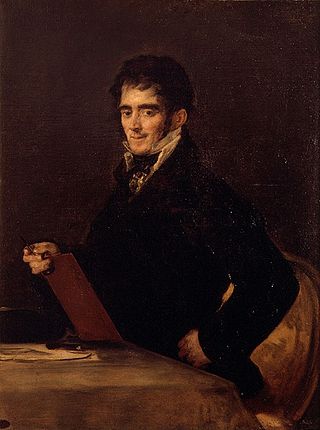
Rafael Esteve Vilella was a Spanish engraver in the Romantic style.
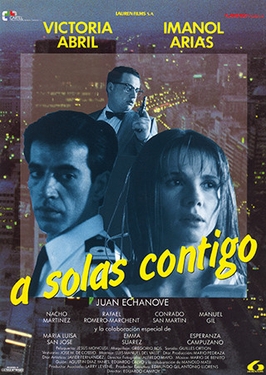
Alone Together is a 1990 Spanish spy thriller film directed by Eduardo Campoy which stars Victoria Abril and Imanol Arias alongside Juan Echanove.

The Drunk Mason is an oil on canvas painted by Francisco de Goya, then reputed painter of tapestries for the royal palaces. It belonged to the fifth series undertaken by Goya, and, like all the pieces that compose it, was painted between 1786 and 1787.

The series of paintings for the alameda of the Dukes of Osuna comprises seven pictures painted by Francisco de Goya between 1786 and 1787. The country estate of the dukes and duchesses, who were the painter's mecenas and friends, was known as El Capricho, and was located on the outskirts of Madrid.


















